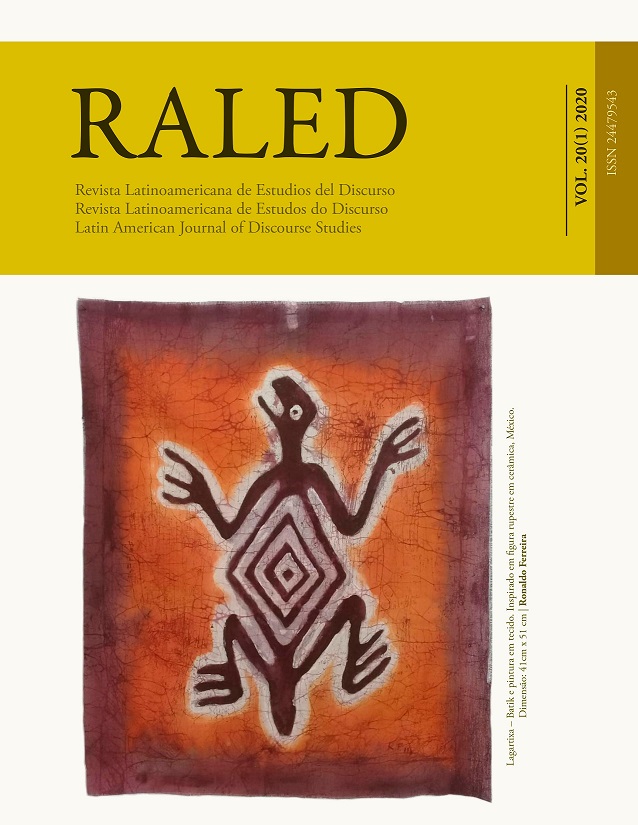The Theory of Information Hierarchization:
a Tool Applied to (Critical) Discourse Analysis
DOI:
https://doi.org/10.35956/v.20.n1.2020.p.4-24Keywords:
critical discourse analysis. information hierarchization. linguistic evidence. social reflection.Abstract
The aim of this study is to demonstrate how the Theory of information hierarchization is an apt and fruitful analytical tool for doing discourse analysis that also has a critical perspective. In order to achieve this purpose, three analyses are presented. The first one studies a written story for children. The second examines a text taken from the television program La Liga. Both texts were used for ad - dressing information hierarchization in the utterances. The third text belongs to the newspaper Página/12 and was used for the analysis of information hierarchization, not only in the utterance, but also in the text. Finally, by means of some brief triggering questions, this study shows how the data obtained with this theory, as linguistic evidence, make it possible to reflect critically on social issues.
Downloads
References
Fairclough, N. 1992. Discourse and Social Change. Cambridge: Polity Press in association with Blackwell Publisher.
Firbas, J. 1966. On defining the theme in functional sentence analysis. Travaux Linguistiques de Prague 1: 267-80.
García da Silva, D. E. 2007. Critical Discourse Analysis and the functional bases of language. En L. Barbara y T. B. Sardinha (Eds.). Proceedings of the 33rd International Systemic Functional Congress, pp. 932-949. São Paulo: PUCSP.
Guba, E. G. y Lincoln, Y. S. 1998. Competing Paradigms in Qualitative Research. En N. K.
Denzin e Y. S. Lincoln (Eds.). The Landscape of Qualitative Research. Theories and Issues, pp. 195-220. Thousand Oaks: Sage.
Marchese, M. C. 2015. Análisis crítico de la representación discursiva de la vivienda en historias de vida de sujetos en situaciones de pobreza urbana y en discursos del Estado. El déficit habitacional en la Ciudad Autónoma de Buenos Aires en la posmodernidad. Tesis Doctoral. Ciudad Autónoma de Buenos Aires: Facultad de Filosofía y Letras de la Universidad de Buenos Aires.
Moliner, M. 1996. Diccionario de uso del español. Madrid: Gredos.
Montecino Soto, L. (Ed.). 2010. Discurso, pobreza y exclusión en América Latina. Santiago: Cuarto Propio.
Pardo, M. L. 1995. La Gestación del Texto: La Emisión Líder. Tesis Doctoral, ms.
Pardo, M. L. 1996. Derecho y Lingüística. Cómo se juzga con palabras. Buenos Aires: Nueva Visión.
Pardo, M. L. 2008. Una metodología para la investigación lingüística del discurso. En M. L. Pardo (Ed.). El discurso sobre la pobreza en América Latina, pp. 55-78. Santiago: Frasis.
Pardo, M. L. 2011. Teoría y metodología de la investigación lingüística. Método sincrónico-diacrónico de análisis lingüístico de textos. Buenos Aires: Tersites.
Pardo Abril, N. G. 2007. Cómo hacer Análisis Crítico del Discurso. Una perspectiva Latinoamericana. Santiago: Frasis.
Pinuer, C. y Oteíza, T. 2012. Principios, competencia y anulamientos en el orden de constituyentes oracionales. Revista Signos 45, 78: 83-99.
Ramalho, V. y Resende, V. M. 2011. Análise de discurso (para a) crítica: o texto como material de pesquisa. Campinas: Pontes.
Resende, V. M. y Ramalho, V. 2006. Análise de discurso crítica. São Paulo: Contexto.
Van Dijk, T. A. 1993. Principles of Critical Discourse Analysis. Discourse & Society. An International Journal for the Study of Discourse and Communication in their Social, Political and Cultural Contexts 4, 2: 249-83.
Wodak, R. 2000. ¿La Sociolingüística necesita una Teoría Social? Nuevas perspectivas en Análisis Crítico del Discurso. Revista Iberoamericana de Discurso y Sociedad. Lenguaje en contexto desde una perspectiva crítica y multidisciplinaria 2, 3: 123-147
Downloads
Published
How to Cite
Issue
Section
License
Copyright (c) 2020 Revista Latinoamericana de Estudios del Discurso

This work is licensed under a Creative Commons Attribution-NonCommercial-NoDerivatives 4.0 International License.
The authors retain the copyright and guarantee RALED the right to be the first publication of the work as well as a Creative Commons Attribution License that allows others to share the work with recognition of authorship and the initial publication in this journal.




